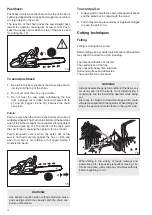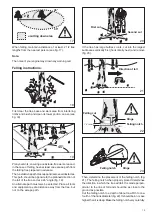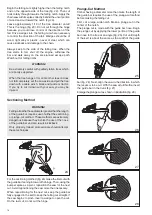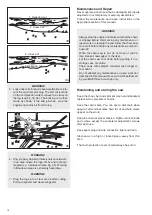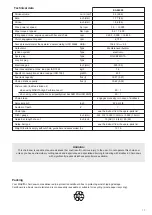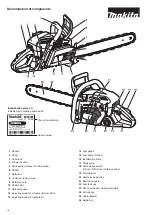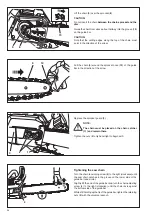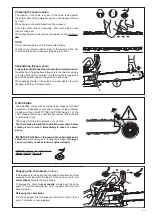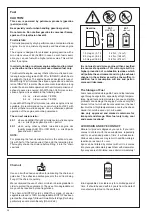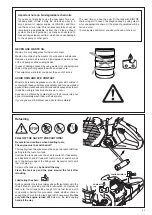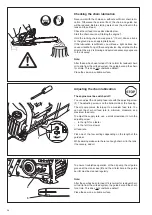
9
7
8
Important adjustments
WARNING!
At correct idle speed, chain should not turn. For direc-
tions to adjust idle speed, see the appropriate section
of this operator’s manual.
Do not use a saw with incorrect idle speed adjust-
ment. Adjust the idle speed yourself according to
the appropriate section of this manual.
Have your MAKITA dealer check your saw and make
proper adjustments or repairs.
Check the saw chain tension frequently, especially
just after installing a new chain. New chains may
stretch more during their initial use. A properly ad-
justed saw chain can be pulled freely around the
guide bar by hand without sagging. Always stop
the engine and wear gloves when checking or ad justing
the chain tension.
Working conditions
Operate your chain saw only outdoors. Operate the saw
under good visibility and daylight conditions only.
WARNING!
Take extreme care in wet and freezing weather
(rain, snow, ice). Put off the work when the weather
is windy, stormy or rainfall is heavy. Clear the area
where you are working.
WARNING!
Avoid stumbling on obstacles such as stumps, roots
or rocks and watch out for holes or ditches. Be ex-
tremely cautious when working on slopes or uneven
ground. There is increased danger of slipping on
freshly debarked logs.
Cutting instructions
Always hold the saw firmly with both hands when the en
-
gine is running. Place your left hand on the tubular handle
and your right hand on grip and throttle lever. Left-handers
should follow these instructions too.
WARNING!
Do not operate your chain saw in semi-throttle position.
Cutting in this position does not permit the operator
proper control of the saw or chain speed.
WARNING!
Never come too close to a rotating chain with your
hands or body.
WARNING!
Cut wood only. Do not use the chain saw for purposes
not intended. For example: do not use the chain saw
for cutting plastic, masonry, or non-wood building
materials.
Use your chain saw for cutting only. It is not designed
for prying or shoveling away limbs, roots or other
objects.
When sawing, make sure that the saw chain does
not touch any foreign materials such as rocks, nails
and the like (fig. 8). Such objects may be flung
off, damage the saw chain or cause the saw to
kickback.
If the chain saw is exposed to force, such as through
impact or falling, inspect the entire chain saw for
proper functioning.
Wrap your fingers tightly around the handles, keeping the
handles cradled between your thumb and forefinger (fig.
7). With your hands in this position, you can best oppose
and absorb the push, pull and kickback forces of your
saw without having it slip out of your grip (see section of
reactive forces).
Make sure your chain saw handle and grip are in good
condition and free of moisture, pitch, oil or grease.
Always start a cut with the chain running at full speed
and the spike bar in contact with the wood.
When starting a cut, the blade can slip to the side or jump
slightly. This depends on the wood and the condition of
the chain.
Therefore, always hold the chain saw with
both hands.
WARNING!
Never use the saw with one hand. You cannot control
reactive forces (see pages 12 to 14) and may lose
control of the saw.


















